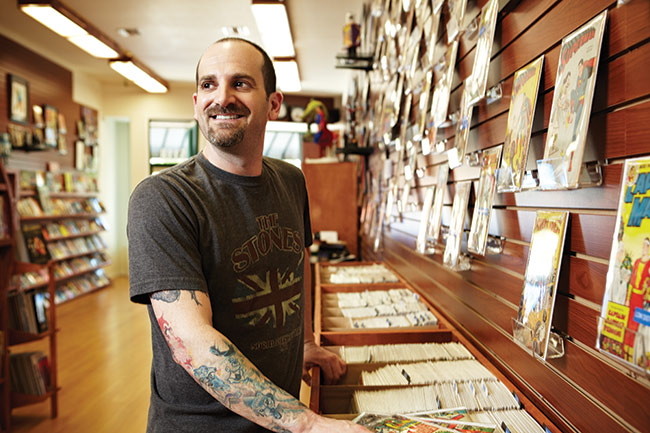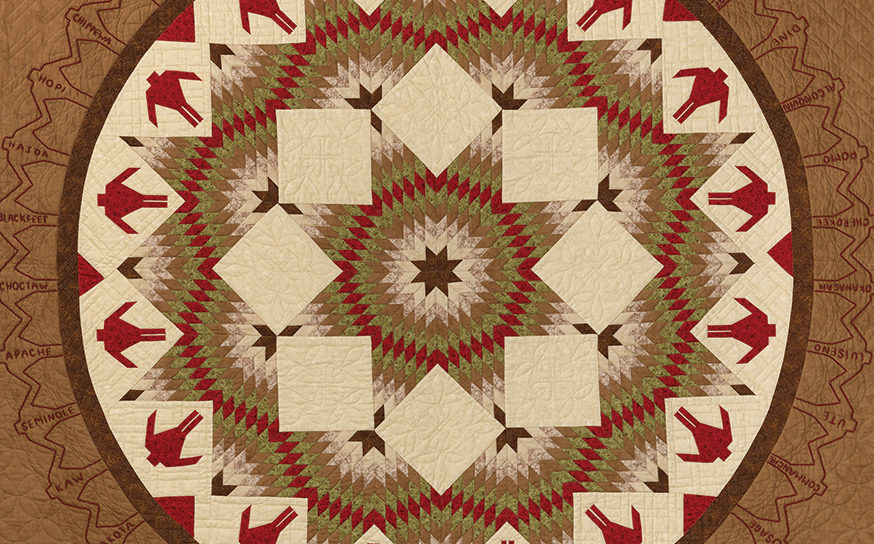
Comic Don
One global trek. Eight diverse shops. An infinite amount of passion. Blastoff’s Jud Meyers shares the inspiration behind his lifelong love of comics, his prolific NoHo store and the real-life metamorphosis of the comic geek into the cool guy.
-
CategoryUncategorized
-
Written byStefan Slater
Superman made his first appearance in Action Comics #1 in 1938—making him 75 this year. Surprisingly, it took Hollywood 40 long years to create a global box office smash starring the famed protector of Metropolis. Richard Donner’s Superman debuted in 1978, and film critics and comic book fans alike view the movie as the forerunner to the ubiquitous superhero blockbusters that flood theatres today.
From Christopher Nolan’s Batman reboots to Joss Whedon’s The Avengers—one of the highest grossing films of all time—Hollywood may have taken its time boarding the superhero train, but it’s safe to say the locomotive is currently rolling faster than a speeding bullet.
Hollywood looks to the original home of superheroes—the much-beloved comic book—for continued inspiration. This summer alone, as hundreds of thousands head to San Diego for the annual Comic Con convention, Man of Steel (June), The Wolverine (July), and The Lone Ranger (July)—all of which originated from comic books—will all hit theatres. With such a large portion of the moviemaking industry residing here, it should come as no surprise that the San Fernando Valley has a vibrant and diverse assemblage of comic book stores that cater to movie producers, animators, artists and everyday fans alike.
There are shops here that appeal to every fan’s particular taste. For comic buffs into the newest volumes and indie comics, there’s Collector’s Paradise in Winnetka. For those after memorabilia (especially Star Wars toys), there’s the recently opened, tightly-packed space in Woodland Hills: PittStop Comics.
But there’s one shop that stands out from the rest—a thousand square foot store with a distinct rocket ship logo on Lankershim Boulevard in North Hollywood. “I don’t stock what I like; I stock what you like and what I think you’ll like,” says Jud Meyers, owner of Blastoff Comics.

Comic connoisseurs will notice, as soon as they walk in, that Blastoff Comics is a remarkedly different. More boutique than comic cave, the atmosphere is sophisticated yet welcoming and illuminated by an abundance of natural light. Custom-built “no end” cherry wood bookshelves and fixtures immediately draw your eye to the comics, graphic novels and classic superhero toys thoughtfully arranged throughout the store. Coupled with the spotless wood floor and neutral color tones, Blastoff seems more like a chic urban art gallery than a casual neighborhood comic store. “When you have something worth ten grand, it is like a piece of art, and you need to make it beautiful when displaying it,” Jud explains. He estimates nearly forty percent of the store’s traffic is women, which, partially explains his decision to carry a large Barnes & Noble like book section. “Whether shopping for themselves or waiting for their, women really like over here,” he says.
A bit of everything is carried here: new issues, collected volumes, indie graphic novels and prose fiction from Warren Ellis, Neil Gaiman and even Ray Bradbury. There’s a kids corner with “Peruvian coin-adorned chairs” and a substantial assortment of collectible comics in the back.
Working with business partner Scott Tipton, a New York Times best-selling author and comic book historian, Jud covers a new superhero theme each month on Blastoff’s website. They also offer special comics on the site that tie in with each theme. (For instance, April was Iron Man month, and Scott provided a detailed history of Tony Stark’s exploits since his first appearance in 1963.)
Jud works with a number of creators, like Mark Waid and Karl Kesel, to offer specialized collections on the store’s website. Many of these works are signed, and some feature YouTube clips of the authors explaining the significance of each piece.
However, what truly sets Blastoff apart from its competition is Jud’s innate ability to dig up whatever comic a customer wants. “I’m your personal shopper. I hunt for you,” says Jud.
If you can’t find what you’re looking for on the floor, chances are Jud will have it in his warehouse—packed with thousands of rare and vintage comics. Rare finds include ‘60s-era Fantastic Four comics or rare prints that feature the first appearance of popular heroes like Wolverine—all almost extinct prizes that can go for thousands of dollars.

Jud has had, you might say, a longstanding love affair with the medium, which was sparked when he was 8 years old. One day, his uncle dropped off a grocery bag filled with comics (including a few ‘70s-era Jack Kirbys). “I knew there were word balloons, but I didn’t see how they correlated,” says Jud. Nevertheless, the Northridge local was hooked almost immediately.
Later on, he’d ride his Huffy on a daily basis to Golden Apple Comics on Reseda Boulevard to check out the new comics. The manager, as Jud fondly recalls, “was a total rock star. He used to be drummer for The Brooklyn Brats, and his girlfriend was Sybil Danning.”
Jud snagged his first job when the manager there hired him at age 12 to sort and organize comics. “I had the Jew ‘fro’ and the glasses. I was the geek who liked comics and a couple of times I got beat up for it,” he laughs, adding “now those very same guys want a job!” From then on, Jud has worked in comic book stores spanning the globe. He moved to New York City for high school, and after graduating, he went to London. When he arrived, as he explains, “The first thing I did was say, ‘Where’s the comic book stores?’”
He began working at Titan Publishing Group in the late ‘80s (the true heyday of the British comic book scene), but he hated working in the publishing world. “I was absolutely terrible at it.”
Eventually, the general manager at Titan walked Jud out of the building and over to Forbidden Planet, a comic shop that the company owned. His supervisor dropped him off with a casual, “He’s all yours.” It was there that Jud learned the basics of the business and was introduced to some of the greatest comic creators in Europe, including Alan Moore, Brian Bolland and Jean Giraud Moebius.
He then moved on to help open two other comic book stores in the U.K.: the comic outlet in the Virgin Megastore and a small, creator-owned shop named Meanwhile Comics, both of which were operated differently. “I learned what works and what doesn’t work at each place,” says Jud.
Jud eventually returned to New York City in 1994 and began working at Joseph Koch’s Avalanche of Wonder (which, by the way, he can say with a perfect Brooklyn accent). At the time, the company was one of the largest international comic book mail-order services in the world.
Jud helped transition their warehouse mail service to an online system, right around the start of eBay. “It was still the Wild West,” says Jud about using the web to sell product. “No one was trying this shit.”

The entire process turned out to be a catalyst—spurring Jud to revaluate his career. “It was fascinating, the idea of I’m not working in a store, and I’m not working in a warehouse. I have all of this product at my disposal, as if it’s mine.”
In 1997, Jud moved back to Los Angeles and opened Krypton Collectibles, his own website shipping service. Some of the product he sold was from his own collection, which he had started when he was child.
He had a walk-in storage unit in New York that was full of comics, and he rented a truck and drove them all back to LA—about 40,000 comics in total. “I was so scared to leave it alone, that I slept in the truck,” he says. “Made it in three days.”
In 2003, he opened his first shop in Sherman Oaks: Earth-2 Comics. Six years later, along with a partner, Jud opened his second Earth-2 at the location of the former Golden Apple store in Northridge.
But change seems part of Jud’s DNA. Last fall, the entrepreneur sold his shares in Earth-2 and opened Blastoff. Jud, who lives in Chatsworth with his wife Stephanie Meyers (executive chef at Bow & Truss) and their eleven year old daughter, loved that the NoHo location was easily accessible by the Metro. He shares that his goals for the company are twofold: increasing its contributions to charity and spreading a love of comics.
“I give a percentage of my sales every month to a different charity,” says Jud, who also helps build reading rooms in hospitals throughout LA. His largest project to date is working with the Gift of Giving Project to construct a library for children in Nairobi, Kenya.
The organization is using four shipping containers to build this library on 10 acres of land donated by the Joy Divine Children’s Organization. The building will share space with an orphanage, and the 10-acre area will be designated (rather fittingly) New Metropolis.
Jud will have a separate container library—with his Blastoff rocket logo on the side—filled with comics of all types for the children. He says he’ll be present on opening day with his daughter, Hannah, to welcome the children.
He believes his love for comics arose from his appreciation for the stories they weave—the tales that everyone, no matter the age or gender, can relate to. Jud points out that Joseph Campbell’s concept of the “Hero’s Journey,” a story line concerning adversity and redemption that’s found in many religious tomes, is also present in many comic books.
Comic books’ universal appeal helps explain the recent rise in popularity of the “geek culture,” which Blastoff’s head honcho sees as a validation of sorts. What once was enjoyed by a few, and often disparaged as being childish by design, is now being seen as meaningful and relevant.
“It’s not just geek culture; it’s culture,” Jud quips. “We’re intellectuals now.”











